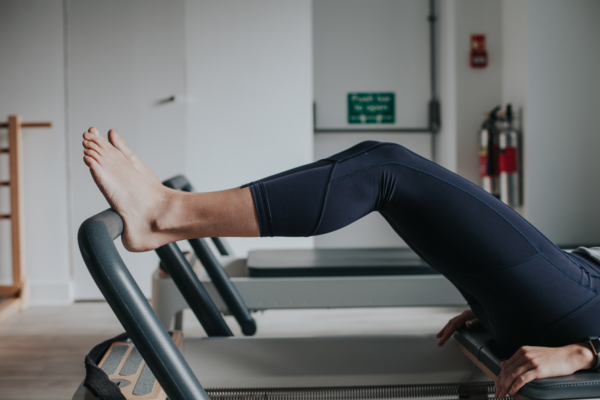Key Contributor: Helen Vassar, Clinical Pilates Instructor
Footwork on the reformer is a fundamental Pilates exercise.
And as such, it is usually one of the first exercises you learn. It is also considered a basic Pilates move and so is often used as preparation for more advanced exercises in classes.
But before you dismiss this exercise as “too easy” or “just for beginners” – listen up.
Because reformer footwork has numerous physical benefits that extend far beyond simply warming up the body. As a result, it deserves to be a focal point – rather than an afterthought – in equipment-based workouts.
You’ll need to be doing this exercise right to reap these benefits, though. So here is how to avoid making this common mistake in reformer footwork, direct from the experts.
What is the Pilates reformer exercise “footwork”?
Pilates footwork is a squat-like movement.
Instead of squatting standing up, however, footwork in Pilates is performed lying down on a reformer machine.
More specifically, this exercise is executed with your back flat on the carriage, feet on the foot bar (with the foot bar up) and head on the head rest.
The action in footwork involves pressing away from the foot bar and extending the legs fully. Bending the legs and going into a squat is the next phase. This brings the carriage back to the starting position.
What do our experts say?
Footwork is a great exercise, especially for those new to Pilates. It’s a great way to starting using the reformer and perfect for those who might be struggling with their squat in standing. With the support of the carriage, you can change the position of the legs, knees and feet without the stress of gravity and work easily on alignment.’ Helen Vassner
Pilates reformer footwork variations
There are many different variations of the Pilates footwork exercise.
One of the ways that the exercise can be varied is by changing the foot position on the footbar.
Placing the ball of your foot or the heels on the footbar changes the emphasis of the exercise.

Pressing through the ball of the foot during footwork means that you are using the same part of the foot that you push off from when walking or running. This means that the movement mimics the functional movement that we use every day. Pushing down through the ball of the foot engages your calf muscles more.

Alternatively, pushing through the heels can help us to engage the gluteal muscles more effectively, it can also be easier and more comfortable for anyone with foot pain.

The feet can be positioned close together, parallel or wide on the bar. The wide version on the heels is a great way to engage the gluteal and back of thigh muscles and mimics the movement of a wide stance squat. This makes it great for warming up for a squat or working on this movement if you can’t weightbear fully through your legs due to injury or post-operatively.

Positioning the feet in ‘V’ shape on the bar creates additional work for the inner thighs whilst performing footwork as they have to work to draw the legs towards each other.
Variety in footwork is also created through changing the spring tension. Depending on the exercise, several springs of different tensions are attached to the carriage. The number and the combination of springs used dictates the weight acting on the person on the reformer.
Not only does this add challenge, but it also alters the very purpose of the exercise being performed.
Using heavy springs on the footwork exercise challenges the strength of the legs, whilst using a light spring on the footwork exercise produces very little workload for the legs, but instead the abdominals have to work to support the weight of the legs and maintain the body position on the reformer carriage.
Footwork variations
There are many options when it comes to foot positions. These include, Pilates V, heels, pads of your feet, arches, as well as feet wide. Adopting these different variations changes the emphasis of the footwork exercise.
Variety in footwork is also created through varying the spring tension. Depending on the exercise, several springs of different tensions are attached to the carriage. The number and the combination of springs used dictates the weight acting on the person on the reformer.
Not only does this add challenge, but it also alters the very purpose of the exercise being performed.
A low-impact exercise
For example, when the carriage is heavier, footwork is usually used as a strength-focused exercise. With the lighter springs, the focus tends to be on accessing the deep stabilising muscles of the pelvis.
However even with all the springs attached to the reformer carriage (the heaviest setting on the reformer), a reformer squat uses much lighter weights than most weighted squats in the gym.
This makes footwork on the reformer a low-impact exercise suitable for people of most ages and abilities.

Footwork in parallel on the reformer
How to avoid this common mistake doing reformer footwork: Your pelvis moves
Moving your pelvis during footwork is a mistake many people new to Pilates makes.
However, if this is happening to you then you’ll want to learn how not to do it quickly. Because poor pelvic control during footwork could result in you leaving your class with a sore back.
Aside from avoiding injury, there are many benefits to performing footwork well. Here are just some of them relating to pelvic control and good spinal alignment:
The benefits of Pilates reformer footwork
Performing footwork in the right way teaches dissociation.
But before we get to that, here’s a brief anatomy lesson: the hip is a ball and socket joint. The hip is healthiest and happiest when the ball moves freely in its socket.
This is where dissociation comes in. It describes the ability of the head of the thigh bone (femur) to glide in the hip socket while the surrounding anatomy stays still. This means that the pelvis and lower back remains quiet, even when there is action at the hip.
Why do we want this?
Ultimately, this is the most natural and efficient way to move. Learning to move this way supports your everyday movements (walking, sitting to standing etc.) and improves things like running technique.
Learning to avoid twisting or tucking the pelvis in this way also takes pressure off the lumbar spine region. This means footwork can help with injury prevention. It can also reduce pain in people with existing back problems.
But if your pelvis moves during the “press” away phase of the exercise then you’re not achieving dissociation. It is also usually a sign that you’ve lost connection to those deep stabilising muscles.
Tips to fix it:
First, bring awareness to this area through touch.
To do so, make a triangle with your thumb and forefinger, letting your palms remain open. Place the triangle on your pelvis just above your pubic bone with your fingers flat against your stomach.
Keep your hands there – this will give you helpful feedback as to what is going on in this area.
Your spine should also be in “neutral” during footwork. This means that there should be a tiny gap between your lower back and the carriage. It shouldn’t be excessively arched though – simply ask yourself “can a breath of air pass under my lower back?” If it can then you’re in the right alignment.
If not, you need to work on finding that neutral alignment (we will have a post on this shortly). Over time, however, practising footwork itself can help you rediscover your spine’s natural curves.

Pressing away from the foot bar
During the footwork exercise
Now, as you start to press away from the foot bar, try to imagine that your sacrum is filled with sand. It is so heavy that it stays anchored to the carriage as you extend and bend your legs.
Let your thigh bones move freely in their sockets by relaxing the front of your hips as much as you can. Trust the equipment and just allow your body to move.
Finally, imagery that can help: As you bend your knees, imagine the thigh bone “tipping” into the hip socket, as if they were water being poured into a bowl.
Using your hands as a guide, you will be able to tell if your pelvis shifts. Your hands should remain flat during all phases of this exercise. If, however, your hands tilt upwards or downwards then you know that your pelvis is tucking under or over-arching. If you feel this happening then take the opportunity to self-correct.
Over time and with practise this will start to come naturally.
If you’re struggling
Check your spring tension. If you’re on a light spring then try a stronger one for more support. Or, why not book in with an experienced instructor. Their guidance can highlight any poor movement habits you’ve developed and help solve them.
Progressions of double leg footwork
Single Leg Footwork


To progress the Pilates footwork exercise, hold one leg floating in the air in tabletop position and press through the opposite leg. With heavy spring resistance this increases the work that you can do with the pushing leg. With reduced resistance, this increases the challenge for your abdominal muscles and stabilising your pelvis flat on the carriage.
Jumping


Another progression of the footwork exercise is jumping work using the jumpboard. Swapping the footbar for the jumpboard provides a wide target for hops and jumps on the reformer. This is a great low impact way of re-training hopping and jumping and creates loads of challenge for your abdominals as they hold the legs unsupported in the air.
If you’ve enjoyed this post then keep your eyes peeled for our upcoming articles on ways to improve your equipment Pilates exercises. But in the meantime, why not try this equipment-like mat exercise and discover how effective the stability ball is as a reformer alternative? Or book today to see how we can help!
Have you tried 1-to-1 Pilates?
Do you need direction when it comes to Pilates Reformer footwork? Then why not come and try a studio class of reformer Pilates in Angel or 1-2-1 session with Complete Pilates London at any of our studios? You can also visit us at our Pilates studio in Kensington and our Pilates studio in the City of London.
Education is key:
These blogs are designed to give information to everyone, however, it is important to remember that everyone is different! If you have not seen one of our therapists and have any questions about injuries, what you have read or whether this may be useful to you, please just ask. We are more than happy to help anyone and point you in the right direction. Our biggest belief is that education is key. The more you understand about your injury, illness and movement, the more you are likely to improve.





